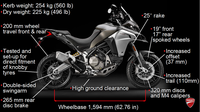Earlier I posted a synopsis of my impressions of the Ducati Multistrada 1200 Enduro's behavior on the street (click here for First Impression: Pavement). Riding the bike on pavement was awesome, but the whole reason I came to Sardinia, Italy, was to ride this new big-bore ADV in the environment it was designed for: the dirt. I got to do that this afternoon, and here's how the big Ducati did.
Right off the bat I was impressed with the engine’s tractability. Between the broad spread of torque offered by 1,198cc of DVT goodness and a super-short first gear, the Enduro is like a tractor at low revs. You can literally let the clutch out in first gear and chug up a hill, and I never felt the need to feather the clutch. With such a solid foundation of torque, you’d have to stall this thing.
As an added feature the Enduro has a “hill holder” function. Apply either brake while stopped on an incline and the ABS computer will hold the rear brake for you, reducing brake pressure as you get moving. I tried it. It works wonderfully and is a really handy feature on such a big bike.
Ducati’s suite of electronics play a big role off road. With the Enduro ride mode selected, the suspension settings are softened, power is reduced to 100 hp, traction control is dialed down to a minimum, and ABS is active on the front wheel only. In other words, there’s a lot of slack in the reins. I could spin or skid the rear tire at will, safe in the knowledge that I wasn’t going to lock up the front tire or get too sideways with the rear. Later in the ride I turned the traction control off since the system was limiting my ability to steer with the rear. In general, though, the off-road traction-control setting is pretty spectacular.
Compared to the standard Multistrada, the Enduro felt out of sorts at speed on the street, but for every point the Enduro is docked on road, it gains two points off road. The larger front wheel and added suspension stroke suck up big hits with ease, and the front end tracked beautifully and never deflected when faced with rocks or other obstacles. The added wheelbase, trail, and rake are likely to thank for the bike's overall off-road stability, which is impressive for such a large motorcycle. Within a few miles I was fully engrossed in the fun of riding—the bike was consistent, stable, and responsive enough that I didn't need to allot much mental energy to the fundamentals of riding and instead was able to focus on choosing my line and enjoying the scenery. In my mind, that's the sign of a well-designed machine.
Ergonomics are well suited to stand-up riding. Ducati changed the footpegs, handlebar, and mirror stalks to make the Enduro more comfortable while “posting,” and it works. Your posture while standing is totally natural, and there’s plenty of room to move around so you have the freedom to maneuver the bike beneath you as you ride.
If there's anything that's holding the Enduro back compared to its competitors (I'm thinking BMW R1200GS Adventure and KTM 1190 Adventure R here), it's weight. It feels heavier than both of those bikes. It is heavier than the KTM and though it's lighter than the BMW, the GS's opposed-twin engine does wonders for that bike's center of gravity, making the Beemer feel lighter than it is. The Enduro is balanced and easy to maneuver as long as you keep it within a few degrees of vertical, but get it off balance and you'll be hard pressed to keep it upright. The 35-inch seat height doesn't help, as it prevents anyone under 6-foot-something from easily dabbing a boot.
All in all, the Enduro is an impressive off-roader and Ducati did a bang-up job of modifying the bike to suit its intended purpose. The fact that I’m making comparisons with the BMW and KTM should tell you just how good it is. Today’s off-road ride had varied and entertaining terrain, but it wasn’t particularly challenging. I’m looking forward to getting an Enduro stateside and riding it alongside the Beemer and KTM on some rougher trails so we can figure out just how good the Ducati is.
I’m also looking forward to delving into the technical details that make the Enduro such a success, which I’ll be doing during the flight back to Los Angeles. So check back soon to learn more about what Ducati did to develop the Enduro and to read my complete First Ride review of the bike.











/cloudfront-us-east-1.images.arcpublishing.com/octane/E4CS3VDG2PVNAZTA4CASQHRPWU.jpg)


/cloudfront-us-east-1.images.arcpublishing.com/octane/MUQLOVLL2ZDGFH25ILABNBXKTI.jpg)
/cloudfront-us-east-1.images.arcpublishing.com/octane/TNOU5DNE2BC57MFPMGN2EIDXAM.jpg)
/cloudfront-us-east-1.images.arcpublishing.com/octane/GTCXACQGJ5HAPDTGWUQKDEH44E.jpg)
/cloudfront-us-east-1.images.arcpublishing.com/octane/S35YGSEMEZB4BLTDJTSZPF4GLA.jpg)
/cloudfront-us-east-1.images.arcpublishing.com/octane/5UOT6HPX2JFMRJAX6EH45AR4MQ.jpg)
/cloudfront-us-east-1.images.arcpublishing.com/octane/OKWOJWAKP5EP3OACCRRWPCIX2Q.jpg)
/cloudfront-us-east-1.images.arcpublishing.com/octane/2WF3SCE3NFBQXLDNJM7KMXA45E.jpg)
/cloudfront-us-east-1.images.arcpublishing.com/octane/G4MG6OUCJNBSHIS2MVVOTPX65E.jpg)
/cloudfront-us-east-1.images.arcpublishing.com/octane/IIGGWFOTOJGB7DB6DGBXCCMTDY.jpg)
/cloudfront-us-east-1.images.arcpublishing.com/octane/QSTCM6AVEZA5JJBUXNIQ3DSOF4.jpg)
/cloudfront-us-east-1.images.arcpublishing.com/octane/U4I7G625B5DMLF2DVIJDFZVV6M.jpg)
/cloudfront-us-east-1.images.arcpublishing.com/octane/B6XD6LS6IVCQPIU6HXDJSM3FHY.jpg)
/cloudfront-us-east-1.images.arcpublishing.com/octane/ICL63FEDDRDTTMINYICCEYGMDA.jpg)
/cloudfront-us-east-1.images.arcpublishing.com/octane/FCGZHQXRBZFLBAPC5SDIQLVF4I.jpg)
/cloudfront-us-east-1.images.arcpublishing.com/octane/WNOB6LDOIFFHJKPSVIWDYUGOPM.jpg)

/cloudfront-us-east-1.images.arcpublishing.com/octane/X33NU3E525ECRHXLNUJN2FTRKI.jpg)
/cloudfront-us-east-1.images.arcpublishing.com/octane/6KKT5NNL2JAVBOXMZYS5ZO76YA.jpg)
/cloudfront-us-east-1.images.arcpublishing.com/octane/J5RKG5O455GMPGQRF2OG6LRT7A.jpg)
/cloudfront-us-east-1.images.arcpublishing.com/octane/GX2CIZKQVRH2TATDM26KFG2DAE.jpg)
/cloudfront-us-east-1.images.arcpublishing.com/octane/ZWIDYSAKQZHD5BHREMQILXJCGM.jpg)
/cloudfront-us-east-1.images.arcpublishing.com/octane/CYUHJZCTSJCH3MRAQEIKXK7SCQ.jpg)
/cloudfront-us-east-1.images.arcpublishing.com/octane/LKOFINY56FCXJCANJ5M7ZDQUBY.jpg)
/cloudfront-us-east-1.images.arcpublishing.com/octane/4NBPDACMWJH63JQYJVK3QRBDZI.jpg)